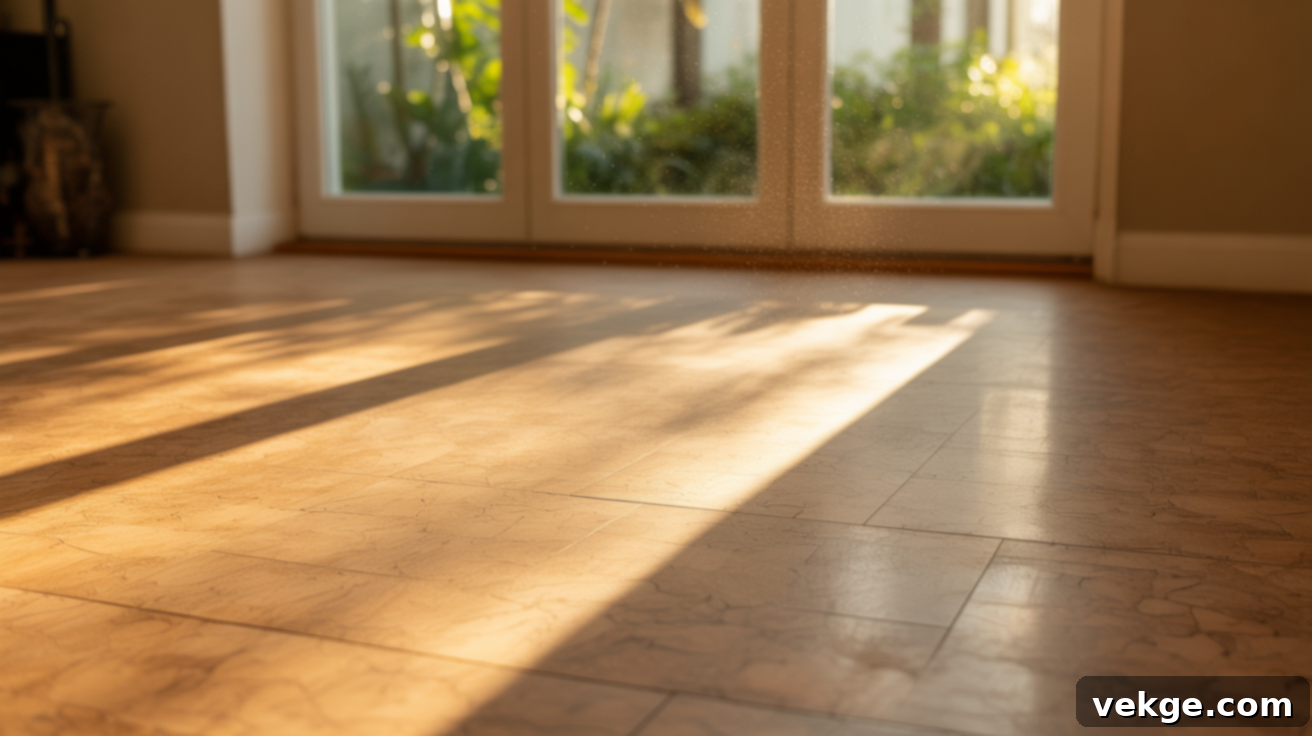Cork Flooring: An In-Depth Look at Pros, Cons, Costs, and Whether It’s Right for Your Home
Choosing the perfect flooring for your home is a significant decision. You want a material that not only looks appealing but also feels comfortable underfoot, stands up to daily life, and aligns with your lifestyle. Amidst a sea of options, cork flooring has steadily gained popularity, celebrated for its unique blend of comfort, sustainability, and practical benefits. But like any material, it also comes with its own set of challenges.
This comprehensive guide is designed to give you a crystal-clear understanding of cork flooring. We’ll meticulously break down its advantages and disadvantages, explore what makes it a compelling choice for many homeowners, and highlight areas where it might not be the best fit. By the end, you’ll have a complete picture of its performance, typical costs, installation considerations, and ideal applications, empowering you to make a confident and informed decision for your next home improvement project.
What is Cork Flooring?
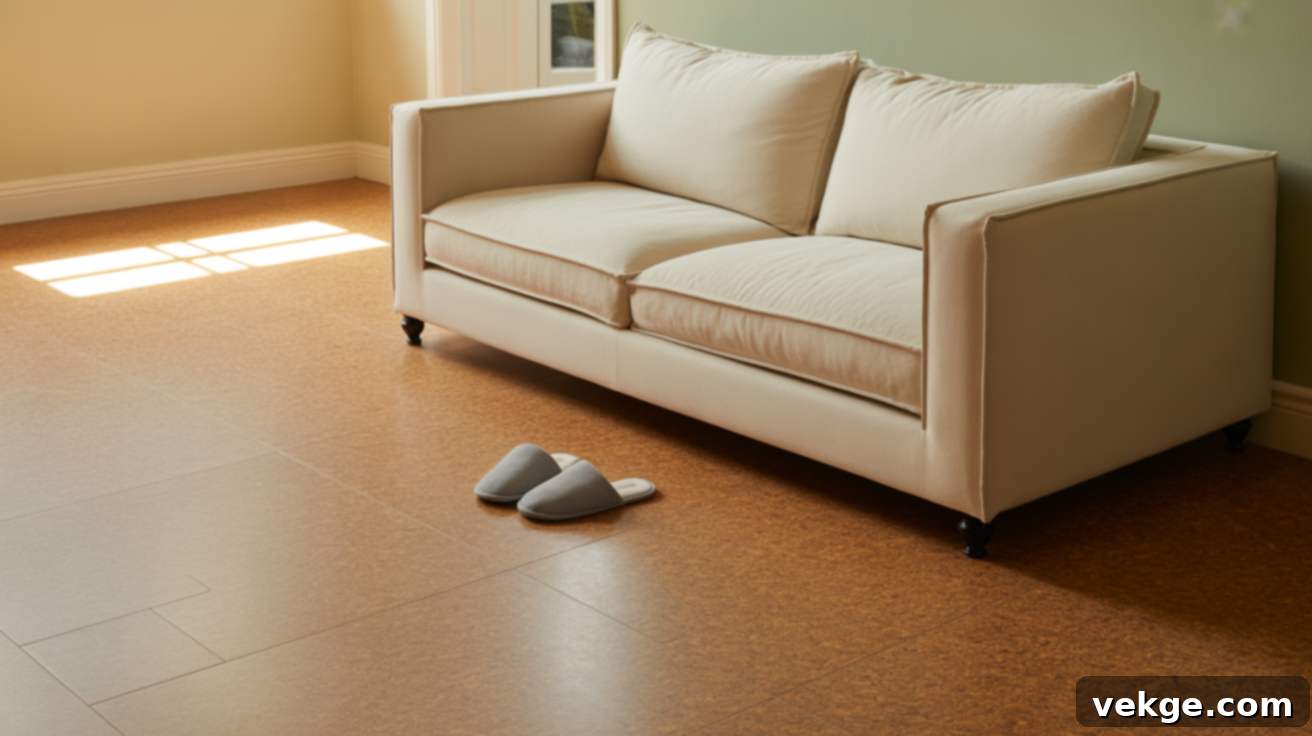
Cork flooring is a distinctive and eco-friendly material derived from the bark of the cork oak tree (Quercus suber), predominantly found in the Mediterranean region, particularly in Portugal. What makes cork truly remarkable is its harvesting process: the bark is carefully stripped from the tree without causing any harm, allowing the tree to regenerate its bark over several years. This makes cork an exceptionally sustainable and renewable resource.
After harvesting, the cork bark is processed through grinding, pressing, and baking into sheets or blocks, which are then used to create various flooring products. A key component of cork is suberin, a naturally occurring waxy substance that provides cork with its inherent resistance to moisture, mold, mildew, and pests. This natural composition contributes significantly to its durability and hypoallergenic properties.
You’ll primarily find cork flooring available in two main formats: planks and tiles. Cork planks often feature a convenient click-lock system, allowing for a “floating” installation over a subfloor without the need for adhesives. Cork tiles, on the other hand, are typically glued directly to the subfloor, offering a more permanent fixture. Both types deliver a characteristically soft, quiet, and warm surface underfoot, enhancing comfort and providing natural insulation throughout your living spaces.
Cork Flooring Pros and Cons: A Quick Look
To give you a quick overview, here’s a summary of the main advantages and disadvantages of choosing cork flooring:
| Pros of Cork Flooring | Cons of Cork Flooring |
|---|---|
| Soft, resilient, and warm underfoot, reducing joint strain. | Prone to dents and scratches from heavy objects, pet claws, or high traffic. |
| Excellent natural sound absorption and thermal insulation properties. | Not fully waterproof—susceptible to damage from standing water or excessive moisture. |
| Naturally resistant to mold, mildew, pests, and allergens. | Requires regular resealing (typically every 3–5 years) to maintain protection. |
| Highly eco-friendly and sustainable, harvested without harming trees. | Limited range of styles, colors, and patterns compared to other flooring types. |
| Relatively easy for DIY installation, especially click-lock planks. | Sensitive to UV light, which can cause fading or discoloration in direct sunlight. |
| Generally more affordable than hardwood, offering good long-term value. | Needs careful cleaning and protection to preserve its appearance and integrity. |
Pros of Cork Flooring
Cork flooring offers a compelling combination of comfort, efficiency, and environmental responsibility, making it an excellent choice for many modern homes. Let’s explore its key benefits in detail.
1. Soft and Comfortable Feel
One of the most immediate and appreciated benefits of cork flooring is its distinctive soft and slightly springy texture underfoot. This natural cushioning is due to the millions of microscopic air cells present in cork’s cellular structure. This inherent resilience acts as a shock absorber, significantly reducing strain on joints and muscles, which is particularly beneficial in areas where you stand for long periods, like kitchens or home offices. Furthermore, cork’s natural composition allows it to retain warmth, ensuring your floors feel pleasant and never cold, even on bare feet during chilly mornings. This unparalleled comfort makes cork a welcoming surface in any room.
2. Quiet and Insulating Properties
Beyond comfort, cork excels as a natural insulator. Its unique cellular structure, filled with air, effectively traps heat, helping to regulate room temperature and potentially lowering your energy bills throughout the year. This thermal efficiency means warmer floors in winter and a cooler feel in summer. Moreover, cork possesses exceptional sound-absorbing qualities. It naturally dampens noise, reducing echoes and the sounds of footsteps or dropped objects. This makes it an ideal choice for multi-story homes, apartments, children’s playrooms, or home offices where a peaceful and quiet environment is highly valued.
3. Naturally Resistant to Mold, Pests, and Allergens
Cork’s natural composition includes suberin, a waxy substance that gives it inherent resistance to moisture, mold, mildew, and common household pests like termites. This makes cork an excellent choice for individuals with allergies or asthma, as it doesn’t harbor dust mites or pet dander. Its smooth, non-porous surface, when properly sealed, is also easy to keep clean, preventing the buildup of allergens. These hypoallergenic and antimicrobial properties contribute to a healthier indoor environment, making cork suitable for bedrooms, basements, and other areas where environmental controls are important.
4. Sustainable and Eco-Friendly Material
For environmentally conscious homeowners, cork stands out as one of the most sustainable flooring options available. The bark of the cork oak tree is harvested without cutting down the tree itself, a process that can be repeated every 9-12 years throughout the tree’s impressive lifespan (up to 200 years). This makes cork a truly renewable resource. The processing of cork bark also typically requires less energy compared to the manufacturing of many other flooring materials like vinyl or some hardwoods. By choosing cork, you support sustainable forestry practices and contribute to the preservation of unique ecosystems, making it a responsible choice for the planet.
5. Easy to Install
Many cork flooring products are designed with DIY enthusiasts in mind. A popular option includes interlocking or “click-lock” planks that float over the existing subfloor, eliminating the need for messy glues or nails. This significantly speeds up installation and makes it a manageable project for homeowners. For a more permanent solution, glue-down cork tiles are also available. Floating installations are particularly appealing for rental properties or temporary updates, while glue-down options offer enhanced stability for high-traffic areas. Both methods generally require fewer specialized tools and less expertise than installing traditional hardwood or ceramic tile.
6. Cost-Effective Option
While not the cheapest option on the market, cork flooring often represents a superior value proposition. It typically costs less than solid hardwood and can be comparable to or even more affordable than high-end luxury vinyl planks (LVP) with similar features. Prices generally range from $2 to $8 per square foot, depending on the quality, thickness, and brand. When you factor in cork’s natural insulation properties, which can lead to reduced energy bills, and its impressive durability with proper maintenance, the long-term cost of ownership can be very favorable. It often requires fewer repairs or replacements compared to other mid-range flooring types, providing excellent value over its lifespan of 10-25 years.
Cons of Cork Flooring
While cork offers numerous advantages, it’s equally important to consider its potential drawbacks to ensure it aligns with your household’s needs and lifestyle. Understanding these limitations will help you make a truly informed decision.
1. Vulnerable to Dents and Scratches
Despite its resilience, cork is a softer material compared to hardwood, tile, or laminate. This makes it more susceptible to dents and scratches. Heavy furniture, especially without protective felt pads, can leave permanent indentations. Pets with sharp claws can scratch the surface, and high heels, hard-soled shoes, or dropped heavy objects can also cause noticeable damage. In high-traffic areas or homes with active children and pets, cork flooring may require extra vigilance and protection, such as rugs in busy zones, to maintain its pristine appearance. While minor scuffs can sometimes be buffed out, deeper damage may be permanent.
2. Moisture Sensitivity Issues
Although cork naturally resists mold and mildew due to suberin, it is not entirely waterproof. It can handle small spills if wiped up promptly, but prolonged exposure to standing water or high humidity is problematic. In areas like bathrooms, laundry rooms, or basements prone to flooding, water can seep into the seams or penetrate the material, leading to swelling, warping, or discoloration. While proper sealing enhances its moisture resistance, cork still performs best in drier environments. For consistently wet areas, fully waterproof alternatives like luxury vinyl or ceramic tile are generally more suitable.
3. Needs Ongoing Maintenance
To protect cork flooring from stains, moisture, and general wear, regular sealing is crucial. Most cork floors require resealing every 3 to 5 years, depending on the level of foot traffic and exposure. Skipping this vital maintenance step can shorten the floor’s lifespan and make it more vulnerable to damage and dullness. Cleaning also requires a gentle approach: avoid harsh chemical cleaners, abrasive scrubbers, or excessive water. A damp mop with a mild, pH-neutral cleaner is recommended for routine upkeep. While daily sweeping or vacuuming is simple, the periodic resealing adds to its long-term maintenance requirements.
4. Limited Style Options
Compared to the vast array of styles, colors, and patterns available for hardwood, luxury vinyl, or ceramic tile, cork flooring offers a more limited selection. Most cork options lean towards natural, earthy tones, ranging from light beige to darker browns, with a characteristic granular texture. While manufacturers are introducing more stained and patterned cork products, you generally won’t find the bold prints, intricate wood grain replicas, or diverse stone-look textures that other materials provide. This can be a significant limitation if you’re aiming for a very specific aesthetic or a highly customized design in your home.
5. Fades in Direct Sunlight
Cork flooring is sensitive to ultraviolet (UV) light and can fade or change color over time when exposed to direct sunlight. This fading can be uneven, particularly if certain areas are consistently covered by rugs or furniture, creating noticeable discrepancies in color once items are moved. To mitigate this, it’s advisable to use curtains, blinds, or shades during peak daylight hours. Applying UV-protective sealants can also help, and regularly rotating rugs and furniture can ensure a more uniform aging process. If your room receives intense, prolonged direct sunlight, be prepared for potential color changes.
Cork vs. Other Flooring Options
To help you weigh your options, let’s see how cork flooring stacks up against some of its popular competitors in terms of comfort, cost, care, and everyday performance.
Cork vs. Vinyl
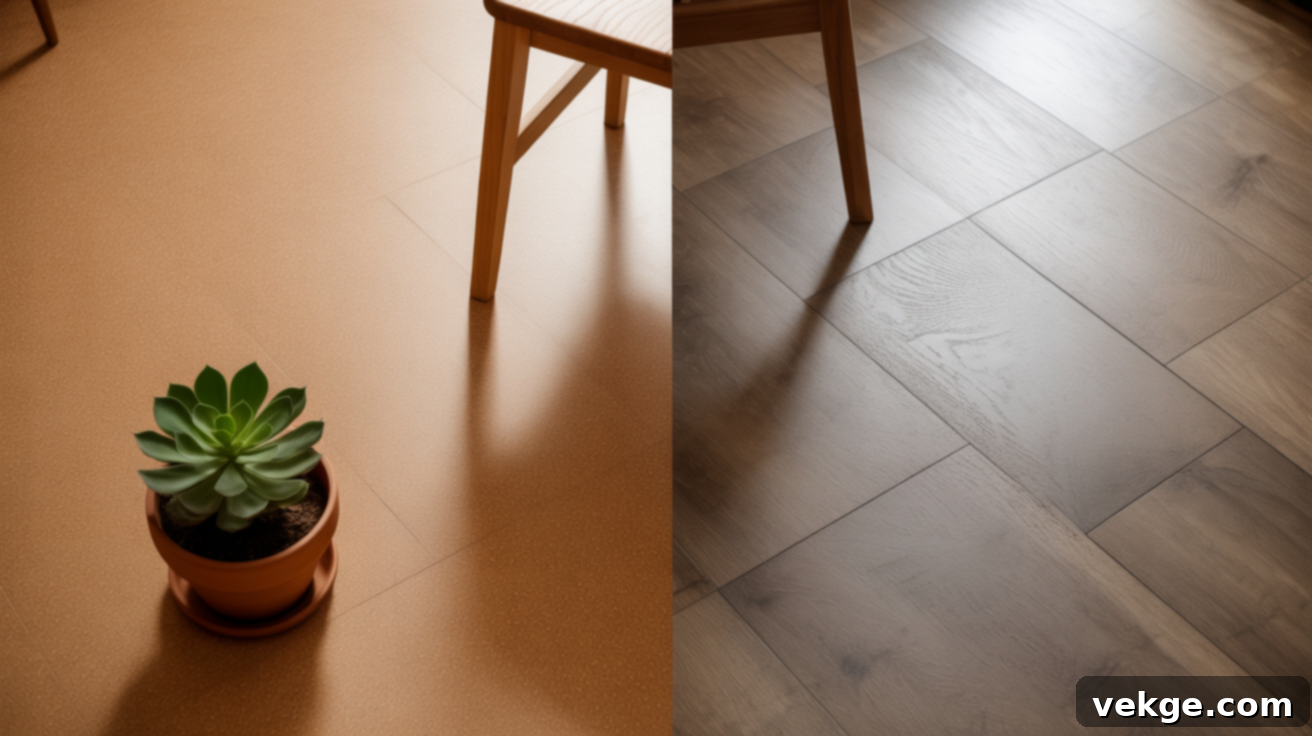
Both cork and vinyl are popular choices, but they excel in different areas. Vinyl offers unparalleled water resistance and durability, while cork provides natural comfort and eco-friendliness.
| Feature | Cork | Vinyl |
|---|---|---|
| Water Resistance | Resists moisture but is not waterproof; needs sealing. | Fully waterproof, ideal for wet areas. |
| Comfort | Softer, warmer, and more cushioned underfoot. | Firmer feel, less natural warmth or shock absorption. |
| Durability | More prone to scratches and dents; needs care. | Highly resistant to scratches, dents, and heavy use. |
| Maintenance | Needs periodic resealing (3-5 years) and gentle cleaning. | Very low maintenance; easy to clean with standard methods. |
| Style Options | Limited patterns, mostly natural earthy tones. | Wide range of styles, colors, and realistic prints (wood, stone). |
| Cost | Typically $2–$8 per sq. ft. | Often slightly cheaper ($1–$7 per sq. ft.) than cork, especially basic types. |
| Eco-Friendliness | Renewable, natural, biodegradable material. | Synthetic, derived from petroleum, not biodegradable. |
If superior water resistance and extreme durability are your top priorities for high-traffic or wet areas, vinyl might be a better fit. However, for natural comfort, warmth, and eco-conscious living, cork is the clear winner.
Cork vs. Bamboo
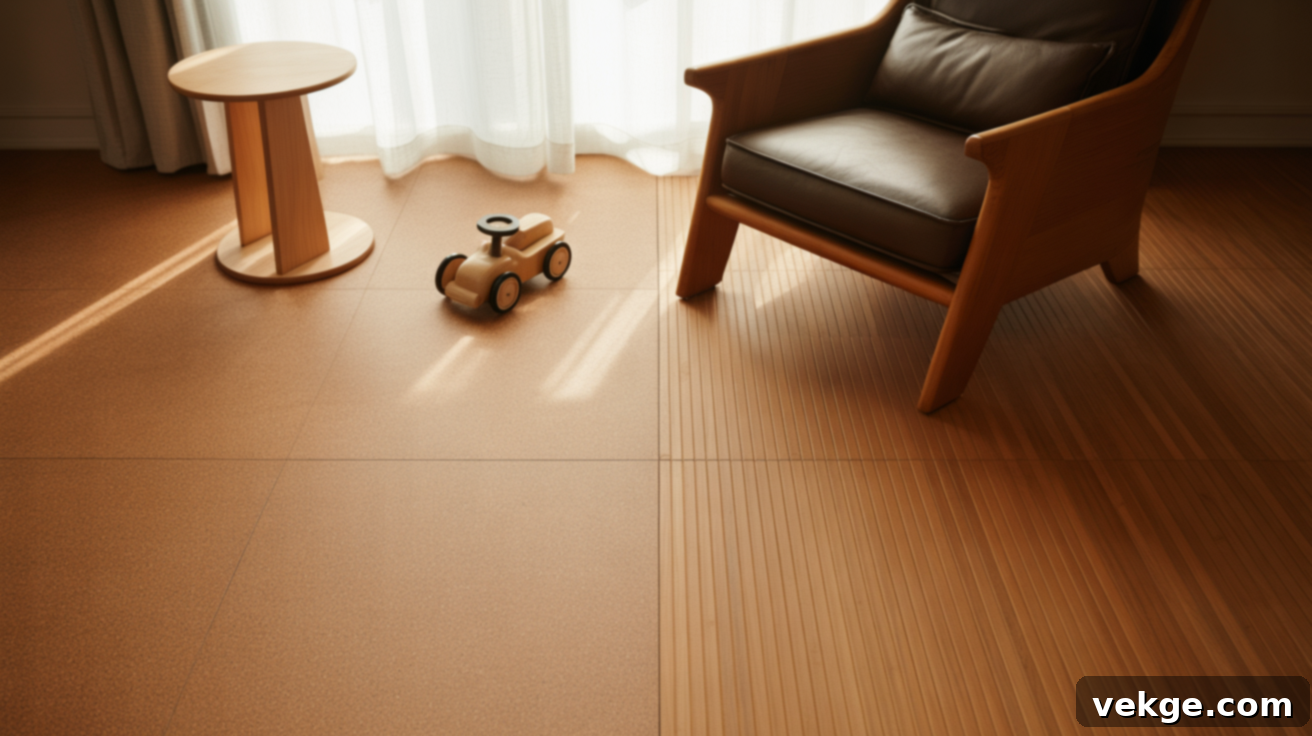
Both cork and bamboo are celebrated as eco-conscious choices, yet they offer distinct experiences in terms of feel, hardness, and maintenance. Here’s a comparison to highlight their differences.
| Feature | Cork | Bamboo |
|---|---|---|
| Eco-Friendliness | Harvested without cutting the tree, highly sustainable. | Rapidly renewable grass, but harvesting removes the plant. |
| Comfort | Soft, cushioned, and warm feel underfoot. | Harder, more rigid underfoot, similar to hardwood. |
| Durability | Softer, more prone to dents and scratches. | Generally harder and more dent-resistant, especially strand-woven. |
| Moisture Resistance | Moderate; needs proper sealing, susceptible to prolonged moisture. | Moderate; needs sealing, can warp or swell with high moisture. |
| Maintenance | Regular sealing and gentle cleaning required. | Similar maintenance to hardwood (polishing, occasional refinishing). |
| Style Options | Natural, simple tones; limited patterns. | Clean, modern finishes; varies from light to dark stains. |
| Best Use | Bedrooms, offices, playrooms, low-to-medium traffic areas. | High-traffic living spaces, kitchens (with caution). |
While both are sustainable, cork provides a unique soft and quiet comfort, making it ideal for specific low-impact areas. Bamboo offers greater hardness and durability, better suited for busier parts of the home that require a more robust surface.
Cork vs. Hardwood
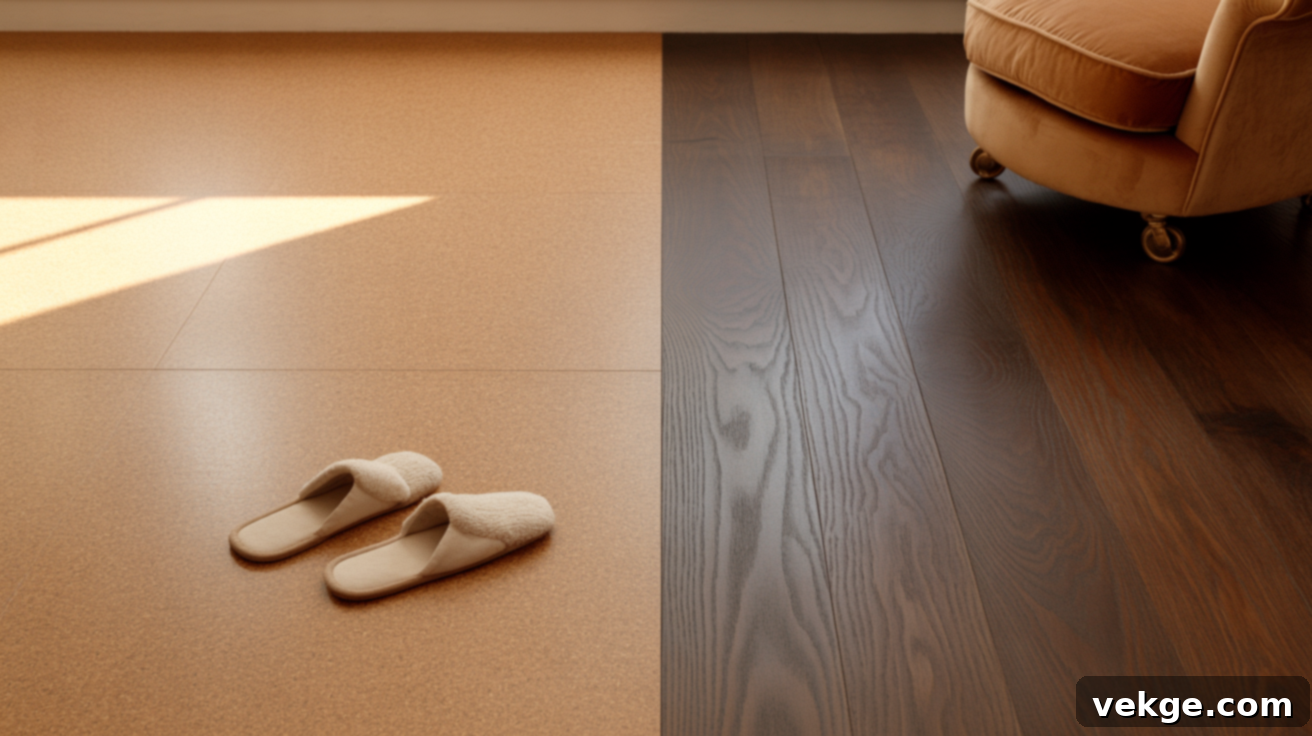
Hardwood remains a timeless and highly valued flooring material, known for its classic beauty and longevity. Cork, however, presents a distinct alternative offering different benefits, particularly in terms of comfort and environmental impact.
| Feature | Cork | Hardwood |
|---|---|---|
| Lifespan | 10–25 years with proper care and maintenance. | 40–50+ years, often lasts for generations. |
| Comfort | Soft, resilient, warm, and significantly quieter underfoot. | Hard, rigid, and can be noisy; less forgiving for falls. |
| Refinishing | Generally cannot be refinished; can be re-sealed. | Can be sanded and refinished multiple times over its life. |
| Maintenance | Needs periodic sealing, gentle cleaning, protection from dents. | Requires polishing, occasional sanding/refinishing, and general care. |
| Fade Resistance | Prone to UV fading in direct sunlight. | Some species and finishes resist fading better, but can still occur. |
| Cost | More affordable upfront ($2–$8 per sq. ft.). | Higher upfront cost ($3–$15+ per sq. ft.) but long-term value. |
| Visual Appeal | Unique, earthy, granular look; simple aesthetic. | High-end, classic appearance; wide variety of wood species and grains. |
While hardwood offers unparalleled longevity and a classic aesthetic that can be refinished, cork excels in comfort, sound dampening, and eco-friendliness. Your choice will depend on whether you prioritize tradition and long-term refinishability or immediate comfort and sustainability.
Where Cork Flooring Works Best
Understanding cork’s strengths and weaknesses is key to placing it in the right areas of your home. Selecting appropriate locations will maximize its benefits and minimize potential issues.
Good Areas for Cork Flooring
Cork flooring truly shines in low-to-medium traffic areas where comfort, quietness, and warmth are highly valued. Bedrooms are an excellent choice, benefiting from cork’s insulating properties that keep floors warm underfoot, especially in colder climates, and its soft surface that is pleasant to walk on barefoot. Home offices are another ideal location, as cork’s sound-absorbing qualities help reduce distractions, and its cushioning provides ergonomic relief for prolonged periods of standing or sitting at a desk. Playrooms or nurseries also benefit greatly from cork’s forgiving softness, which cushions falls and absorbs the sounds of active play, creating a quieter and safer environment for children. These spaces typically remain dry and experience less abrasive wear, making them perfect for cork’s natural attributes.
Riskier Areas for Cork Flooring
Conversely, some areas of the home pose significant challenges for cork flooring due to its sensitivity to moisture and propensity for damage. Bathrooms, laundry rooms, and mudrooms are considered high-risk zones. The constant exposure to high humidity, splashes, and potential standing water can lead to swelling, warping, or permanent damage, even with well-sealed cork. Similarly, entryways and kitchens, while common flooring areas, can be problematic. Entryways expose cork to grit, dirt, and water tracked in from outside, which can scratch the surface and wear down the sealant quickly. In kitchens, spills are frequent, and the presence of heavy appliances can lead to dents. While cork can be installed in kitchens with extra precautions (like rugs, meticulous sealing, and immediate spill clean-up), fully waterproof and more durable materials like tile or luxury vinyl are often a safer long-term bet for these demanding spaces.
Maintenance Tips for Cork Flooring
With proper care, cork flooring can retain its beauty and functionality for 10 to 25 years. Adopting a simple, consistent maintenance routine is crucial for its longevity and appearance. Here are essential tips to protect your investment:
- Seal Regularly: Reapply a protective sealant every 3 to 5 years, or more frequently in high-traffic areas. This is vital for guarding against moisture penetration and wear.
- Daily Cleaning: Sweep or vacuum your cork floors daily to remove dust, dirt, and abrasive debris that can cause microscopic scratches and wear down the finish over time.
- Gentle Mopping: Damp mop monthly using a mild, pH-neutral cleaner specifically designed for cork or wood floors. Never use excessive water, steam mops, or harsh chemical cleaners, as these can damage the finish and the cork itself.
- Protect from Furniture: Place felt pads or furniture glides under the legs of all furniture, especially heavy items. This will prevent dents, scratches, and scuff marks when furniture is moved.
- Use Area Rugs: Strategically place area rugs or mats in high-traffic zones, such as entryways, hallways, and in front of sinks or stoves, to protect the cork from wear, spills, and impact. Ensure rugs have non-slip backings that are safe for cork flooring.
- Manage Sunlight Exposure: Rotate area rugs and furniture periodically to ensure even exposure to light and prevent uneven fading. During peak sun hours, close blinds or curtains, or consider applying a UV-blocking floor sealant to minimize discoloration.
- Prompt Spill Cleanup: Wipe up spills immediately to prevent moisture absorption and staining. Cork is resistant, but not impervious, to liquids.
Conclusion
Cork flooring offers a truly unique blend of advantages, providing exceptional comfort, natural warmth, sound dampening, and impressive eco-friendly credentials. Its ability to create a quiet, soft, and healthy indoor environment makes it an attractive choice for many homeowners. However, as we’ve explored, it also comes with specific considerations, including its vulnerability to dents and scratches, moisture sensitivity, and the need for ongoing maintenance like periodic resealing.
Ultimately, the decision of whether cork flooring is the right fit for your home hinges on your specific needs, lifestyle, and priorities. Carefully consider the intended room, the level of foot traffic, your tolerance for maintenance, and your design preferences. With proper installation and consistent care, cork can be a durable, beautiful, and deeply satisfying flooring solution that enhances your living space for years to come.
If you’re still exploring options or need ideas for other rooms in your home, don’t hesitate to check out our other comprehensive guides and simple tips on the website. We’re here to help you navigate the world of flooring and choose the perfect surface for every space.
